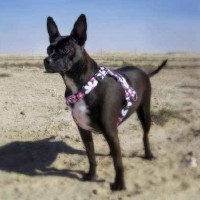Appearance of the Bospin
|
| Although the exact physical description of the Bospin varies with each individual, it's common for most dogs of this designer breed to have a mesocephalic head and brown eyes. These dogs have small muzzles and a narrow but long nose. Their upright ears will be oversized and the teeth will meet in a uniform bite. The neck is not broad and the body can be described as delicate, with slender front legs and flat hindquarters. These dogs have small paws that will have black pads and nails. The tail of this breed will generally be docked. The Bospin tends to take on some of the basic characteristics of the Miniature Pinscher. This usually includes their small, muscular bodies supported by long, lean legs. This makes them very athletic and fast animals. They will also take on the large, erect, triangular ears. |
Temperament of the Bospin
|
| The Bospin's personality is a cross between the Boston Terrier and the Miniature Pinscher. These fun, bouncy little dogs are great pets and will crave human interaction. They are fairly even-tempered, excitable at times and lazy at others. These dogs love to please and will be easy to train as long as you are clear, patient and show plenty of positive reinforcement. They rarely bark and may not be good watchdogs, but they are known to be quite athletic and skilled in many canine sports and activities. They can be calm and welcoming to strangers as long as they are properly socialized. Teach them to respect you as a leader from the start and to develop a strong bond with your dog so that he will be loyal and obedient. This breed can sometimes be dominant with other dogs, but with obedience training this can be corrected. On the whole, they are very affectionate and cuddly animals. |
Needs and activities of the Bospin
|
| This breed of dog doesn't require a lot of activity, but must always remain active. They will adapt to the amount of exercise offered to them. This means they can become lazy if you allow it, but will be active if they are available. They should average between 30 and 60 minutes of activity every day to keep them in shape. |
Maintenance of the Bospin
|
| This breed has a short coat that requires minimal maintenance, but should always be brushed regularly. They should be bathed from time to time and should also have their teeth brushed, ears cleaned and nails trimmed. To prevent dental disease, try to brush your dog's teeth as often as possible. Daily brushing is preferable, but should be done at least two or three times a week. To keep their ears healthy and free from infection, check and gently clean them every week with a damp cotton ball. Trim your dog's nails as often as he needs. This varies with all dogs, as some are more active and wear out nails faster than others. Check if they're too long once or twice a month, and if you hear them clicking on the ground when your pet goes for a walk, you should cut them immediately as they're overdue. |










 English (United Kingdom)
English (United Kingdom)